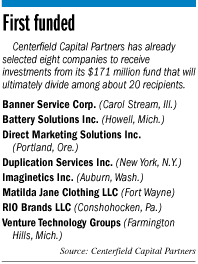Subscriber Benefit
As a subscriber you can listen to articles at work, in the car, or while you work out. Subscribe NowAn Indianapolis private investment firm has raised one of the largest-ever funds in the state.
Centerfield Capital Partners pulled in $171 million that it plans to invest in about 20 companies. Its two previous funds totaled $60 million and $116 million.
The fund places Centerfield behind Hammond Kennedy Whitney & Co., which closed on $202 million in 2007.
 Hiatt
HiattCenterfield is a mezzanine investor—typically a mix of subordinate debt and equity to help fund expansions or acquisitions—that targets niche manufacturers and business service providers, as well as distributors and health care providers.
“We look for industries that are asset-light; can move and adjust to trends in a marketplace; are managed by really smart, resourceful people; and have a history of growth and profit,” said Centerfield founding partner Tom Hiatt.
The firm closed fundraising April 30 after more than two years, and eight companies have already divvied up about a quarter of the investment pool.
It shot past an initial $150 million goal after existing investors responded with enthusiasm.
About half the $171 million came from returning investors, most of whom are institutions—primarily banks, pension funds and insurance companies.
Roughly one-third of the investors are based in the Midwest, with the rest scattered throughout the United States, plus a handful abroad.
Centerfield expects to take another two to three years to finish investing the fund—the average is five companies per year.
 Lutzke
LutzkeWithin a year of investing all of Centerfield’s third fund, the firm will likely start preparing for its fourth.
“It wouldn’t surprise me if the next fund-raise is incrementally larger,” Hiatt said.
Hiatt and his partners would not reveal specific investment returns for the previous funds.
Founding partner Scott Lutzke said the firm has justified itself to its investors.
“The institutions that invest in Centerfield could invest, and do invest, on a global basis,” he said. “There are many, many other places that they could put their money. So if we didn’t have a pretty good, consistent return …”
A smattering of individual announcements from Centerfield over the years show some investments yielded returns over 20 percent; one was more than 50 percent.
The sheer fact that investors would turn attention to central Indiana reveals a strong performance, said Jim Birge, a partner at Faegre Baker Daniels who focuses on corporate finance, among other areas.
“The money speaks, and the fact that they’ve been able to raise, by central Indiana standards, a fairly sizable amount, [the returns] must have been strong,” Birge said.
Centerfield’s style
Centerfield has invested in more than 40 companies since it began in 1998.
 Hook
HookAbout half the companies are in the Midwest. One of the beneficiaries of the latest fund is in Indiana, children’s clothing designer Matilda Jane Clothing in Fort Wayne.
Centerfield’s deals typically range from $4 million to $12 million.
The firm has invested roughly two-thirds of its money in subordinate debt, a staple of mezzanine funding that takes priority below bank loans secured by collateral if the company defaults. But subordinate debt is cheaper for the borrowers than selling ownership stakes in their companies.
The remaining third of Centerfield’s money has gone into equity.
On average, the firm owns 20-percent stakes in its companies.
 “We’re very flexible with the mix, and we’re typically investing both kinds of capital into the same company,” Lutzke said.
“We’re very flexible with the mix, and we’re typically investing both kinds of capital into the same company,” Lutzke said.
“The template would be … say we put in $10 million, we put in $6.6 million in sub[ordinate] debt and $3.3 million in equity. But any specific company, we can be 50/50, 90/10. So we’ll typically have some equity investment and ownership.”
What margins mean
To qualify for investments, companies need revenue between $15 million and $100 million a year.
Earnings before interest, taxes, depreciation and amortization margins are usually more than 14 percent, said partner Matt Hook. The recipients for the most recent fund average 21-percent margins.
“You see a lot of companies that are out there under 10 percent,” Hook said. “What it says with this EBITDA margin, there’s value to that company. There’s a reason that company exists.”
Investments steer away from automotive and other heavy industry, which is known for high-volume, low-margin business models.
Partner Faraz Abbasi said Centerfield is interested in companies that have carved out niches where they lead their markets and have few competitors.
Recent investments have run the gamut from an outdoor furniture manufacturer in Pennsylvania to a battery recycler in Michigan.
 Abbasi
Abbasi“When we go through our investment criteria checklist, prior to taking the next step of our due-diligence process or taking the next step in evaluating the deal, we focus quite stringently on the market and its growth prospects and the size of it,” Abbasi said.
Looking at leadership
Screening companies also involves multiple types of audits and evaluations by accountants, market researchers, information technology experts, even psychologists to help understand managers’ strengths and weaknesses.
“The results that this team has been able to produce over years is a strong indication of how well they’ll do in the future,” Hiatt said.
Even with minority stakes in its companies, Centerfield will sit in on board meetings, either as active members or as observers.
Steve Edris, CEO of Wabash-based Thermafiber Inc., one of Centerfield’s portfolio companies, credited the investment firm’s board involvement with helping his company hit record-setting revenue of more than $50 million last year.
Centerfield provided $4 million in subordinate debt in 2007 to Thermafiber, which makes wool insulation for commercial and industrial buildings. The investment funded an acquisition by company management and a group of outside investors.
“We’ve had some of the biggest capital reinvestment in the company in the past 25 years,” Edris said. “That was nice. It helped our profitability.”•
Please enable JavaScript to view this content.
